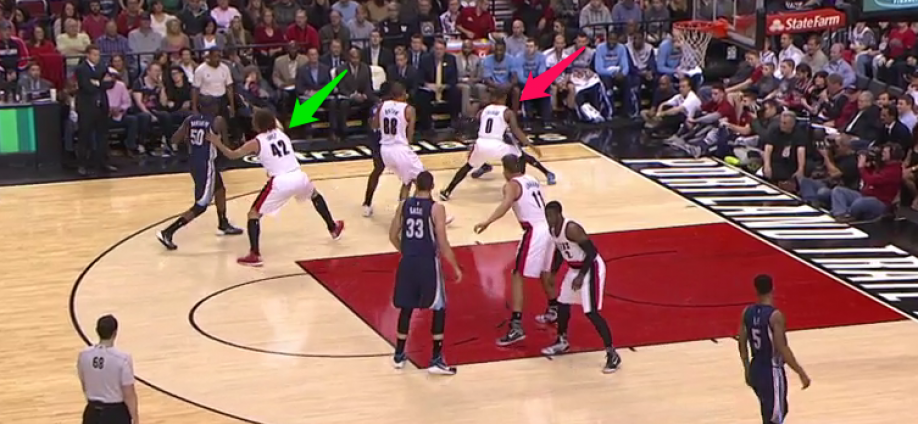NBA Sports Betting Quick Links

Our first trip for making sense of NBA stats that don't make sense is to Portland, where we examine what's been an excellent defense this season and markedly improved from where they have been the past couple years, especially against points guards. The main reason for their success has been the individual improvement of Damian Lillard as both an on-the-ball and off-the-ball defender. Lillard was one of the worst defensive point guards in the league when he came in as a fairly aged rookie, so many still label him as such, and some of the stats still coincide with that thinking, but I don't believe it to be true anymore.
Here are the stats that seem to contradict each other:
The Blazers allow just a 21.6 EFF (Efficiency) Rating to point guards on the season, good for 6th in the NBA on the year.
The Blazers allow an average of 41.9 fantasy points per game to the point guard position, good for just 22nd in the NBA.
Why do these numbers contradict themselves? It's because of the style of defense that the Blazers play. They force the ball handler to be the one to beat them most of the time, the exact opposite of what the Clippers do for instance, which is double the ball handler and force him to pass. Most often, that ball handler is going to be the point guard. Not always, but by far the most often. This causes the opponents primary creator to have a more voluminous, but less efficient outing most of the time when they play Portland.
Let's take a look at some plays as examples.
First, a wing dribble handoff. The pink arrow indicates the player who will be receiving the ball and his primary defender (Mike Conley, the Grizzlies PG and Lillard) and the green arrow represents the primary help defender on this play, Robin Lopez.

As you can see in this second screenshot, the primary help defender on the play actually drops down into the lane to prevent an easy pass by Conley and Lillard is forced to fight through two screens, able to barely get much of a hand up. Still, with Conley having his foot on the three point line, one of the worst shots in basketball, the Blazers have gotten what they want here, an inefficient shot. This makes Lillard look bad, but he's simply doing what's asked of him.

Second, let's look at a more common play, the pick and roll. The primary ball handlers here is in pink (Jeff Green) and the green arrow (Meyers Leonard) the primary help on this play. Many teams would either double or switch here to get the ball out of the creator's hands, but the Blazers like to avoid these switches, as this one would leave the undersized Wes Matthews on one of the NBA's best post up players, Randolph.

In the second image here, you can see Leonard hang way back into the lane to prevent the easy pass to Randolph, his original man and is waiting for Wes Matthews to chase his man down. This play ends up being a 14-foot runner by Green, not a particularly efficient shot and the Blazers have again prevented an easy pick and roll layup by Randolph for a shot from distance.We'll look at one more pick and roll with Conley that I think really emphasizes how much the Blazers want to force primary ball handlers to take mid range jumpers. On this play we have the Grizzlies most common pick and roll duo setup for a weak side two-man game. The pink arrow (Conley), his screener and his primary defender are all bunched on the wing, but the primary help defender, the green arrow (Kaman) has stayed far from the action.

We'll look at one more pick and roll with Conley that I think really emphasizes how much the Blazers want to force primary ball handlers to take mid range jumpers. On this play we have the Grizzlies most common pick and roll duo setup for a weak side two-man game. The pink arrow (Conley), his screener and his primary defender are all bunched on the wing, but the primary help defender, the green arrow (Kaman) has stayed far from the action.

As you can see in this final image, Conley turns the corner easily on Lillard, who has no help, as Kaman has barely moved, protecting the rim. Conley has that 17-foot jumper basically anytime he wants to take it in this game, but he knows that's not an efficient shot. Despite Kaman standing directly in his lane to the basket, Conley tries to force the ball to the roll man, Gasol, who isn't expecting the pass. It goes out of bounds for the turnover.

All in all, this was a productive fantasy game for Conley as the Fantasy Points Allowed numbers would suggest, as he finished with 15 points, 8 assists and nearly 40 fantasy points. He finished the game well above his season averages in what I consider the two biggest “usage" factors, shot attempts and assists. He averages 12.9 FGAs on the year and took 15, while he averages just over 5 assists per game and racked up 8 in this one. However, his efficiency was way down, as the Blazers EFF rating would indicate as he made just 6-of-15 of those attempts, well below his season field goal percentage of almost 46%.
Scott Malewig is a proven daily fantasy basketball expert and writer at Daily Fantasy Cafe. You can follow him on twitter @Sports_25toLife


Login or Register to join the conversation.